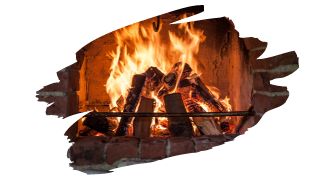As a rule of thumb, different tree species produce varying levels of heat. But generally, the denser the lumber, the more heat it will generate.
This is why hardwoods tend to be better for burning, because they produce a good amount of heat.
But what about softwoods such as Douglas Fir? Softwoods are typically less dense than their hardwood counterparts. And that can mean they may struggle to produce as much heat as hardwood lumber.
So, what does all of this mean for that stack of Douglas Fir firewood?
Well, in this post, you’ll learn what you need to look out for if you want clean burning firewood. You’ll also discover the one key thing that makes Douglas Fir a less-than-ideal choice for an indoor fireplace.
And we reveal the two best types of affordable wood that also make for great fireplace fuel.

This post may contain affiliate links to products that we receive a commission for (at no additional cost to you). Learn more here.
What Is The Best Kind Of Firewood For A Fireplace?
If you want a clean burning firewood, then your choice of lumber should meet three important criteria:
1). Firewood Needs To Be Dry
If firewood still has a high moisture content in it, then it will emit a lot of smoke as it burns. That’s because when you burn that log, the moisture in it will vaporize. And that creates all of that excessive smoke.
This is why you should rarely burn freshly cut lumber — and not only because it may struggle to catch light. Rather, wood that’s been freshly cut from a tree, has a moisture content of 100%.
But, if you allow firewood to dry first, (referred to as seasoning), you can get it’s moisture content to under 20%. And it’s at this low moisture content level that firewood burns cleanly.
2). Firewood Must Contain Very Little Sap Or Pitch
Another thing you need to watch out for in firewood, is the amount of natural sap contained in it. If there is a lot of sap in firewood, this too can cause a high amount of smoke.
However, more worryingly, that high sap content will add to soot residue build-up in a chimney flue. And this is one of the key causes of chimney fires.
3). Firewood Needs To Be Made From Wood That Is Not Poisonous.
Certain types of lumber are very carcinogenic, such as Camphor wood. And some trees are even downright poisonous, such as the Yew tree.
Burning these particular types of trees as firewood, will turn their poisonous sap into vapor. And no home needs to be filled with those kinds of dangerous fumes.
So What’s The Cleanest Burning Firewood For An Indoor Fireplace?
White Oak and Birch wood are two great options for clean burning fuel. They contain very little sap, and they are not poisonous trees either.
They can take a while to season (as all trees do). But once dry, they won’t emit loads of smoke.
Another great advantage to using Oak or Birch for firewood is their density.
High density woods burn hotter, and for much longer, than low density lumber. And Oak and Birch are two dense hardwoods that easily fit the bill for hot slow burning firewood.
Related Post: Can You Safely Burn OSB In A Wood Stove?
And What Of Douglas Fir? Does Douglas Fir Wood Burn Well?
Well, Douglas Fir isn’t suitable for firewood for one key reason; it can contain a lot of sap. Like many other types of softwoods, (such as Pine), Douglas Fir can produce a lot of sap.
You see, Douglas Fir trees suffer from sap overflow. And this is usually a result of the trees natural defense mechanism kicking in.
That resinous sap overflow is there to kill off any bugs and insects that may be attacking its tree stem. And bug-attacks are enough of a regular problem that many Douglas Fir trees weep with sap.
Check out Find In Natures quick video below to see just how much sap a Douglas Fir tree can produce:
So, burning Douglas Fir in a fireplace poses an increased risk of a chimney fire.
Now, you can combat this risk by cleaning out your chimney much more frequently than usual. But, there is little you can do about the problem of excessive smoking from sap-filled Douglas Fir Wood.
Related Post: What Is The Best Treatment For Douglas Fir Porch Decking?
Does Douglas Fire Wood At Least Burn Hot Enough For A Fireplace?
Douglas Fir is less dense than White Oak or Birch wood (according to their Janka ratings). The Janka rating measures the hard density of a piece of wood.
Douglas Fir has a Janka rating of 660 lbf, meaning it takes 660 pounds of force to crush this lumber.
However, White Oak is much denser with a 1360 lbf Janka rating. And even Birch wood dwarfs Douglas Fir with its own 1260 lbf Janka rating.
Now, it’s lower density means that Douglas Fir won’t produce as much heat as either Birch or Oak. And this is reflected in their comparative BTU’s.
The BTU rating measures how much energy it takes to burn any given material. The more energy it takes, the higher the BTU. And the higher the BTU, then the hotter that firewood will burn.
Douglas Fir has a BTU (British Thermal Unit) of 20.7 BTU. On the other hand, Birch wood has a BTU rating of 23.6 BTU. While White Oak has a BTU rating of 25.7 BTU.
What Does This Mean For All The Douglas Fir I’ve Got Lying Around?
In short; Douglas Fir doesn’t make for a great choice firewood (for an indoor fireplace).
It’ll likely create excessive amounts of smoke and soot. And even if you manage to find Douglas Fir that isn’t filled with sap, it won’t produce as much heat as say Oak wood.
Although, if you have an outdoor fire pit that needs kindling, then Douglas Fir will do in a pinch.
To Wrap Up, Here Are The 3 Key Takeaways From This Post…
- 1). Clean burning firewood shouldn’t contain much sap. Burning sap-filled timber, (in a fireplace), can increase soot build-up in chimney flues, and cause chimney fires.
- 2). Douglas Fir trees tend to produce a lot of sap, in order to combat insect and bug attacks.
- 3). Douglas Fir doesn’t produce as much heat as White Oak or Birch wood.
References:
Wood Heating | Utah State University
Chimney Fires And Their Causes | StovesOnline.co.uk



